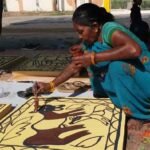Ranchi, Nov 12 (UNI) Renowned folk artist Sughia Devi from Hazaribagh has given new identity and prominence to the traditional Sohrai painting, an age-old tribal art form deeply rooted in the soil and culture of the region.
Sohrai art, believed to be thousands of years old, is traditionally painted on mud walls and depicts the beauty of life, nature, and harvest festivals. It has been preserved and passed down through generations of women belonging to tribal communities such as the Kurmi, Santhal, Munda, and Oraon groups.
Recalling her journey, Sughia Devi shared that she learned the art from her mother. As a child, she would accompany her to nearby caves, where they collected natural pigments from the earth to create colours and painted on mud walls.
Today, she not only continues the practice but has also trained hundreds of rural women, empowering them to achieve self-reliance through art. Her contribution to promoting and preserving Sohrai art has earned her national recognition, and even Prime Minister Narendra Modi has lauded her efforts in bringing the art form to wider attention.
“Sohrai painting is not just an art form it is a celebration of life and gratitude to nature,” Sughia Devi said. Traditionally created after the harvest season, women paint figures of deities, animals, and flora using mud, cow dung, and natural pigments on freshly plastered walls, symbolising fertility, prosperity, and harmony with nature.
Taking the art beyond the walls of rural homes, Sughia Devi has successfully adapted Sohrai designs onto sarees, textiles, and decorative handicrafts, helping the tradition find a place in modern markets and global exhibitions.
Her work has been displayed in major cities across the world, including London, New York, and Tokyo, earning international acclaim for Jharkhand’s folk heritage.
As part of Jharkhand Foundation Day celebrations, the walls of Ranchi have been adorned with Sohrai paintings created by Sughia Devi and her team, showcasing the cultural essence of the state.
However, she acknowledges the challenges of preserving this tradition amid rapid modernisation. “Traditions survive only when they are nurtured and lived,” she said, underscoring her mission to pass on the legacy to younger generations.











